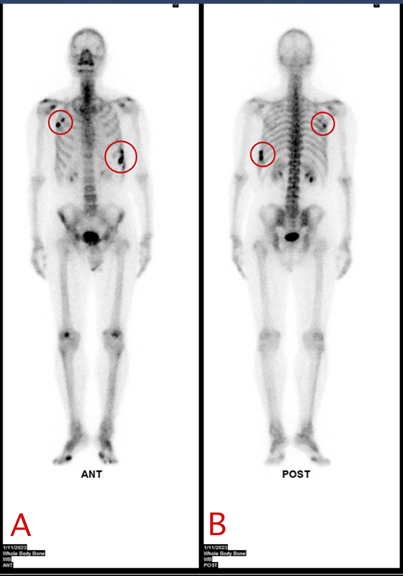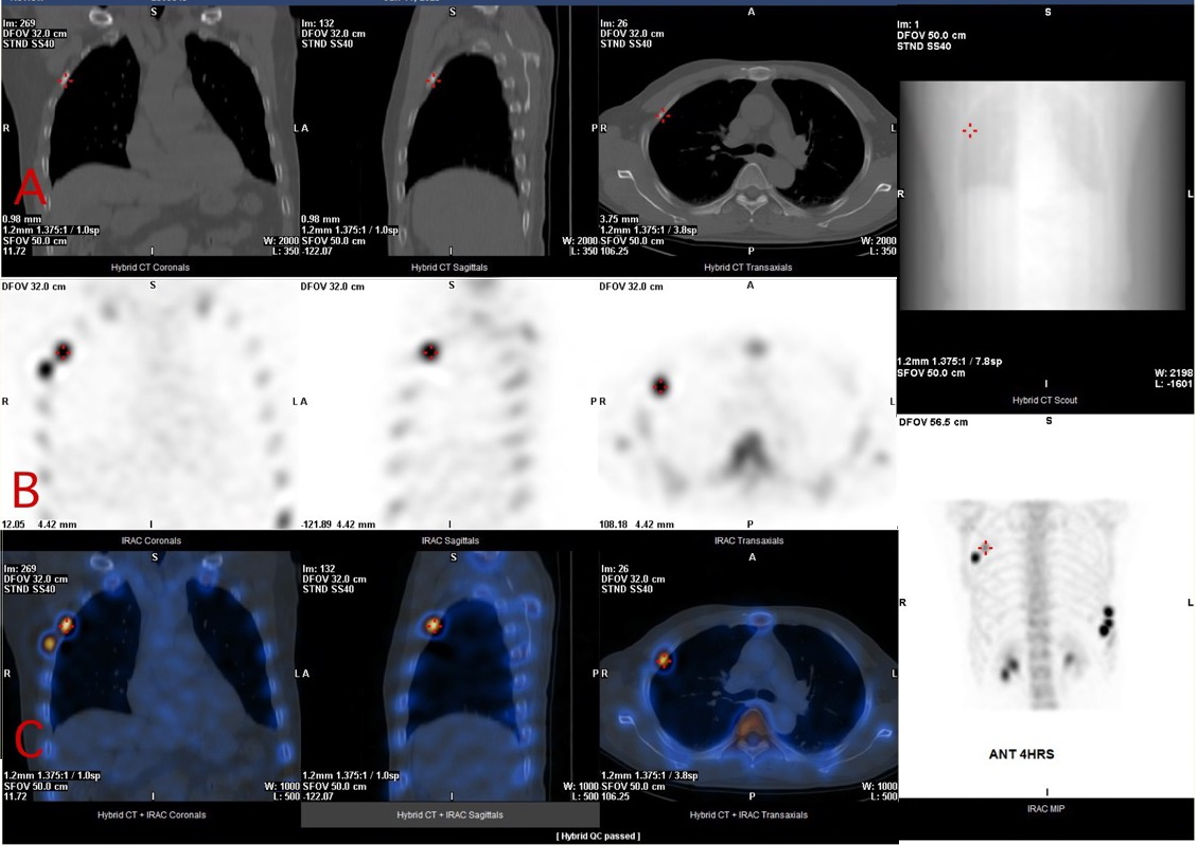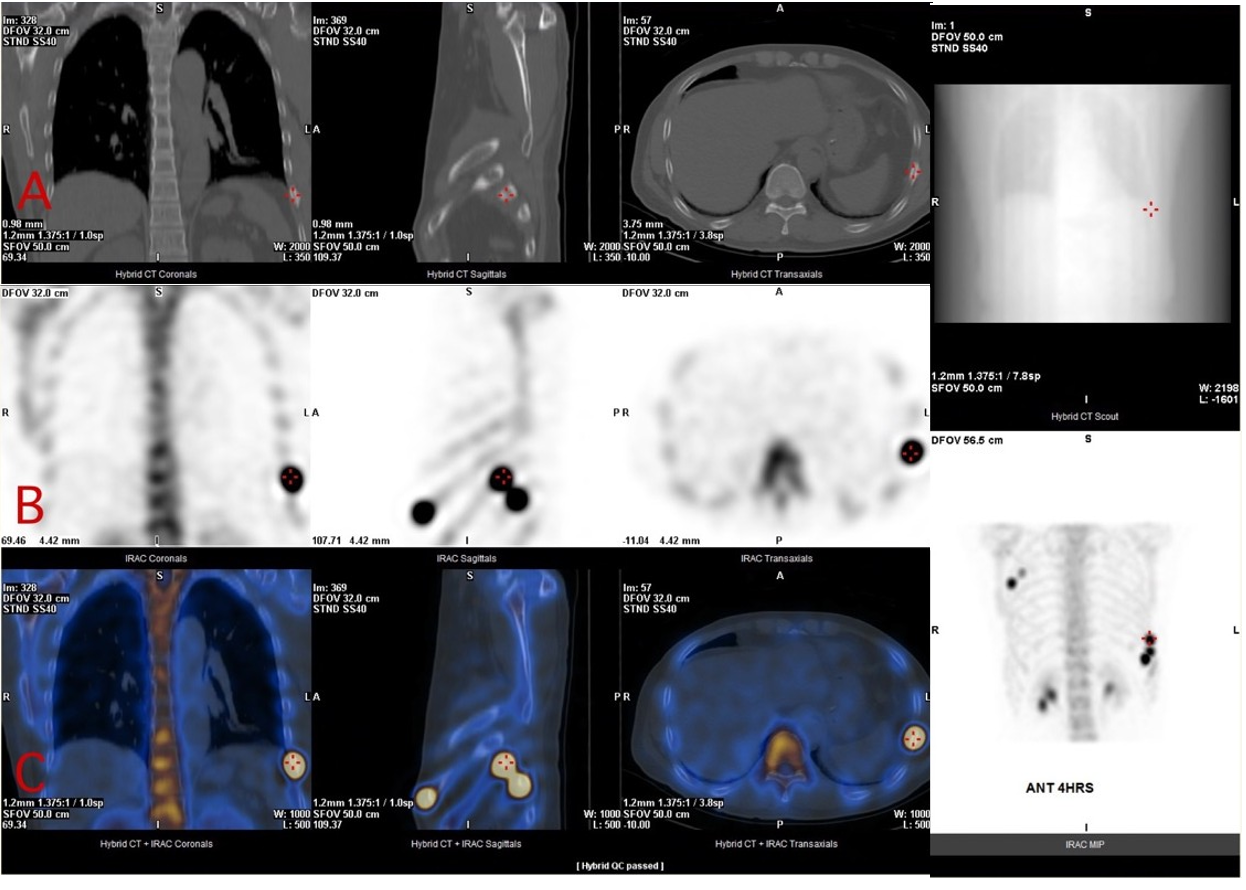MOJ
eISSN: 2374-6939


Case Report Volume 15 Issue 2
1School of Medicine, National Defense Medical Center, Taipei, Taiwan
2Department of Physical Medicine and Rehabilitation, School of Medicine, Tri-Service General Hospital, National Defense Medical Center, Taipei, Taiwan
3Department of Physical Medicine and Rehabilitation, Kaohsiung Veterans General Hospital, Kaohsiung, Taiwan
Correspondence: Dr. Shin-Tsu Chang, Department of Physical Medicine and Rehabilitation, Kaohsiung Veterans General Hospital, Department of Physical Medicine and Rehabilitation, School of Medicine, Tri-Service General Hospital, National Defense Medical Center, Taiwan
Received: March 08, 2023 | Published: March 24, 2023
Citation: Tsan Yu H, Danielle AGT, Chia Ying L, et al. Subclinical rib fractures detected by SPECT/CT imaging in a patient with chest wall pain following a car accident. MOJ Orthop Rheumatol. 2023;15(2):50-55. DOI: 10.15406/mojor.2023.15.00617
Background: Hairline rib fracture commonly happens after blunt trauma, and it is hard to be detected by X-ray. Many methods can be used, and among them, the hybrid image of single-photon emission computed tomography (SPECT) and computed tomography (CT) seems to produce higher sensitivity for diagnosis.
Case presentation: A 63-year-old man came to our rehabilitation clinic after a vehicle accident 25 days earlier. He had multiple plain films focusing in injured areas, but nothing was detected. However, he persisted in pain in the right and left chest walls individually before and after, which worsened every time when he coughed and bent over. Patient was examined with whole body bone scan and SPECT/CT, and showed out the definite fracture of right ribs 3-4 and left ribs 8-10. The patient then received medicine for pain-killer and rehabilitation modalities at the chest wall.
Conclusions: We present a patient with a subclinical rib fracture initially, which is later diagnosed by the hybrid images of SPECT/CT. We conclude that hybrid images of SPECT/CT produces more precise diagnoses for the hairline rib fracture in field of scintigraphic rehabilitation.
Keywords: subclinical rib fracture, single-photon emission computed tomography, computed tomography
Hairline fracture, a single and non-displaced rib fracture, is classified as a small crack or bruise within a bone. Patients with it may have constant chest wall pain and bony tenderness which can bother the patient for several months. This type of fracture is more difficult to be detected compared to displaced types. And the most common mechanism causing rib fractures is blunt trauma, which exerts pressure directly on the ribs to cause them to break.1
Most of the time, chest wall X-ray is the first line tool to detect rib fractures after blunt trauma. According to a study by Tomas,2 however, up to 50% of rib fractures are ignored at plain radiography, even while images with appointed oblique rib views have been achieved. As a result, if there is no abnormality found from the X-ray image(s), the next step will depend on patient’s symptoms. The computed tomography (CT) scan has been considered to detect subclinical rib fracture. But similarly, a study that compare the sensitivity of CT in detecting rib fracture with MPR and VR (image post-processing techniques), reveal that although post-processing CT improve the sensitivity, the incidence of occult fractures remained 19.2% (112/584).3 In contrast, skeletal scan with single photon emission computed tomography (SPECT) is seldom used but it does exert high sensitivity in detecting rib fractures. In our case, we find out the subclinical rib fracture by the hybrid SPECT/CT image, which precisely depicts the location of the broken ribs.
Patient, a 56-year-old man, had a car accident with hitting against his chest wall on November 13, 2022, and afterward, he felt pain at the right-sided chest wall. He went to the ER of our hospital, where all the examinations including plain X-ray films did not show any abnormalities in the rib cage. However, pain took place at the left-sided chest wall since December 2, 2022, which worsened since December 5, 2022, when the patient lift a heavy briefcase at work. Since then, every time the patient felt chest wall pain when he coughed, bent over, or woke up in the morning. On December 10, 2022, the patient visited our rehabilitation clinic, where the physical examinations reveal local tenderness of the chest wall in the both sides. We arranged the skeletal scintigraphy for early detection, which shows increased uptake (hot spot) over the anterior right 4-5th ribs and lateral left 8-10th ribs (Figure 1). The hybrid images with SPECT/CT scan show exact abnormality at the each corresponding positions (Figures 2-6). The diagnosis of hairline fracture of ribs, right ribs 3-4th and left ribs 8-9-10th was made. The patient then received non-steroidal anti-inflammatory drug (Voren-G gel, 10 MG/G 40G, TID) for one month and got treated by rehabilitation modalities, such as low-level laser therapy (LLLT) and transcutaneous electric nerve stimulation (TENS) at the chest wall (right upper part + left lower part), six times a month. The chest wall pain completely resolved in two months.

Figure 1 Whole body bone scan of the case. A, B is the final radioactivity image when the Tc-99m MDP was injected intravenously 3 hours later. A is anterior and B is posterior. The red circles depict the abnormal uptake of radiotracers, which can be seen at right upper ribs and left lower ribs.

Figure 2 Nuclear scintigraphy with hybrid image of the patient’s rib cage. (A) CT scan of the lesioned rib. (B) Bone scan image with obvious lesioned rib in black. (C) SPECT image of the right 3rd lesioned rib with a red cross on it.

Figure 3 Nuclear scintigraphy with hybrid image of the patient’s rib cage. (A) CT scan of the lesioned rib. (B) Bone scan image with obvious lesioned rib in black. (C) SPECT image of the right 4th lesioned rib with a red cross on it.

Figure 4 Nuclear scintigraphy with hybrid image of the patient’s rib cage. (A) CT scan of the lesioned rib. (B) Bone scan image with obvious lesioned rib in black. (C) SPECT image of the left 8th lesioned rib with a red cross on it.
For this case, although there is no abnormal finding from the X-ray, the hybrid images of SPECT/CT did a definite diagnosis due to high uptake at the patient’s ribs. This situation can be seen either in early healing phase of the right upper ribs, or in later of the left lower ribs. We affirm that SPECT/CT might be more accurate in detecting hairline fractures of ribs compared to chest X-ray films, no matter what the callus formation achieved or not.
Fractures of chest rib are frequent after direct anterior trunk trauma, occurring in 60–80% of all injuries.4 Generally, the symptoms of stress fracture include chest wall bruising, redness, bony tenderness, constant chest wall pain, and sometimes decreased ability to perform full inspiration due to pain.5In our case, besides bruise and a decrease in inspiration, the patient experienced all the above symptoms. Also, during the initial examination of the right upper chest, a hairline rib fracture was not detected. This leads the patient to perform normal daily activity continuously including lifting heavy briefcases using the left hand.
However, the strenous activity aggravated the patient’s potential left chest injury, so he started to feel left lower chest pain after then. It gave us a lesson that we cannot conclude there is no problem just because no abnormalities can be found. Many activities can increase the burden on the ribs during repairing/healing stage, such as lifting heavy objects, lying, and coughing.6 Thus, we need more precise diagnoses to let patients know what the problem is and then have a better prognosis.
The CT scan is a gold standard for detecting fractures, like rib(s);5 however, it also has a limitation in the detection of ribs fracture. In a study from Korea, viewing 130 patients with blunt chest trauma examined by CT scan, 52 patients with rib fractures were subclinical.7 As a result, the addition of SPECT may be a helpful way to raise its sensitivity. In one study comparing the sensitivity of SPECT, CT, and SPECT/CT in 97 patients who had been confirmed to have benign rib diseases, the results showed the sensitivity to be 50.52%, 83.51%, and 92.78%, respectively.8 The results emphasized that hybrid images of SPECT-CT increases sensitivity for diagnosis of rib lesions compared to planar images. As we knew, the whole body bone scan also possesses high sensitivity to rib lesions.9,10 However, a case who has prostate cancer was suspected to have bone metastasis based on a whole-body bone scan, but was then confirmed as a rib fracture from the SPECT/CT hybrid image later.11 This shows hybrid SPECT/CT may provide better diagnostic power in etiology than a bone scan. All in all, SPECT/CT possesses high sensitivity and better etiology survey when compared to other examination tools, particularly in early or subclinical skeletal lesion. We already have some experiences in early detection of neck facet joint arthritis,12 sternoclavicular arthritis,13 and meniscus tear of knee joint.14
Combination of SPECT/CT images is handy for acquisition in order of both structural and physiological information with a high degree of image fusion accuracy. The prototype SPECT/CT device was first commenced in 1992,15 and the marketable SPECT/CT was first commenced in 1999, showing combination of a dual-detector varying-angle gamma camera and a low-dose X-ray tube mounted on the identical scaffold.16 Japan researchers successfully performed intervening the hardware components into an integrated system to build up algorithms for SPECT attenuation correction using CT (2002).17 Accuracy of coregistration has conveyed as 3 mm or better in SPECT-CT (2008).18 Since the first commercial device, a bunch of SPECT-CT hybrid systems are springing up like mushrooms with different CT capabilities going from single-slice to multi-slice systems. Generally speaking, images attained from a CT region are helpful for anatomical localization, but structural detail is better illustrated by diagnostic quality (i.e. multi-slice) CT (2009).19 This is mostly significant in the skeleto-articular system, where CT depiction rather than localization only may offer valuable additional information of the radionuclide site(s).
In our case, we check the patient’s rib cage with SPECT/CT, and found out the subclinical rib fractures. Given the functional details of SPECT and the anatomic facts of CT, hybrid images of SPECT/CT present better attenuation correction, raised specificity, and exact interpretation of the localization of disease, and possible involvement of neighboring tissues.15,16,20,21 It is helpful in the field of scintigraphic rehabilitation.
None.
The authors declare no conflicts of interest.

©2023 Tsan, et al. This is an open access article distributed under the terms of the, which permits unrestricted use, distribution, and build upon your work non-commercially.